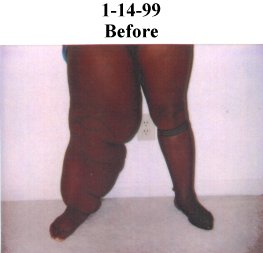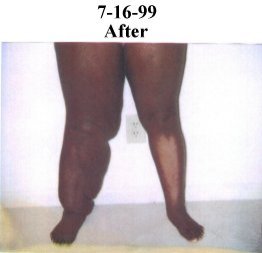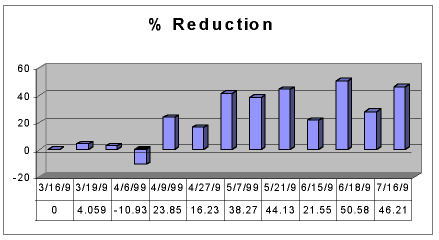


This 47-year-old female presented with stage III lymphedema to the right leg. She states her edema began nine years prior after receiving treatment for cervical cancer. Her treatment in 1987 included a partial hysterectomy and radiation therapy. She had metastasis to the spine, which was also treated with radiation. She had two hospitalizations for cellutis. She experienced lymph fluid leakage from the pores of her skin.
Clinicals / Case Studies
47yr Old Female Stage III Lymphedema
47 year old - female
s/p Cervical Cancer
Treated with surgery and radiation 1989
s/p Cervical Cancer
Treated with surgery and radiation 1989
She initially was treated with pump therapy but found it unsuccessful and states it caused her pain. In January of this year she sought treatment through Joanna Burgess RN of Lymphodynamics II in North Carolina. Her treatment plan included Complete Decongestive Therapy and the ReidSleeve®. To date she has responded extremely well to treatment showing an approximately 50% reduction (see graph).
The patient has been followed very closely utilizing our EdemaCalc® system. Measurements are sent in on a regular basis and entered into our program. A graph is then produced depicting the progress. This graph is presented to the therapist for review and assistance in determining ongoing treatment or adjustments to the current treatment plan. As you can see by her graph, the progress was slow at first, and subsequent adjustments were made to her treatment plan. Higher and lower graphical readings further assist in suggesting when a change of treatment is indicated and whether it was affective or not.
She will continue with her treatment and we will update her condition and progress. She has just ordered the OptiFlow® EC to enhance her bandaging. Where she is wearing her ReidSleeve in-between treatments and at night, she is bandaging during the intensive portion of her therapy. During this time she will utilize our OptiFlow EC to optimize the bandaging.
We are excited about her progress to date and are delighted that she was willing to share her history and subsequent quest for treatment. We thank Joanna Burgess for providing such thorough data and the opportunity to present this case.
She will continue with her treatment and we will update her condition and progress. She has just ordered the OptiFlow® EC to enhance her bandaging. Where she is wearing her ReidSleeve in-between treatments and at night, she is bandaging during the intensive portion of her therapy. During this time she will utilize our OptiFlow EC to optimize the bandaging.
We are excited about her progress to date and are delighted that she was willing to share her history and subsequent quest for treatment. We thank Joanna Burgess for providing such thorough data and the opportunity to present this case.




